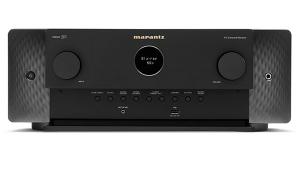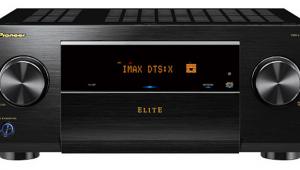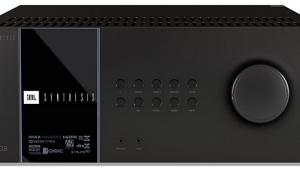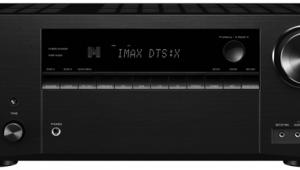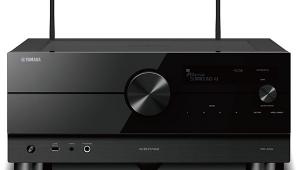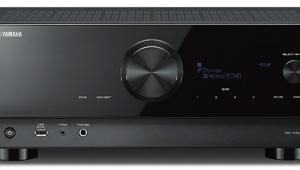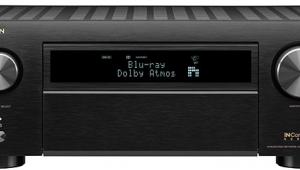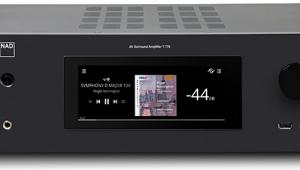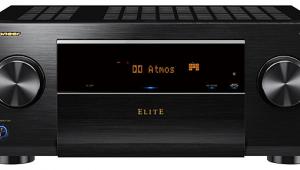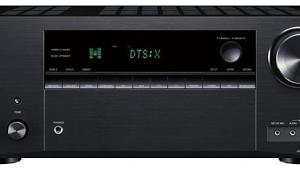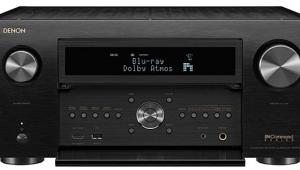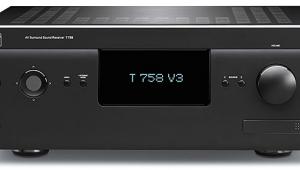Denon AVR-1612 A/V Receiver HT Labs Measures
Five channels driven continuously into 8-ohm loads:
0.1% distortion at 71.5 watts
1% distortion at 79.8 watts
Analog frequency response in Direct mode:
–0.05 dB at 10 Hz
–0.01 dB at 20 Hz
–0.03 dB at 20 kHz
–3.11 dB at 50 kHz.
Analog frequency response with stereo signal processing:
–0.50 dB at 10 Hz
–0.15 dB at 20 Hz
–0.13 dB at 20 kHz
–17.93 dB at 50 kHz.

This graph shows that the AVR-1612's left channel, from DVD input to speaker output with two channels driving 8-ohm loads, reaches 0.1% distortion at 103.9 watts and 1% distortion at 118.5 watts. Into 4 ohms, the amplifier reaches 0.1% distortion at 73.4 watts and 1% distortion at 141.5 watts.
There is no multichannel analog input to measure. THD+N from the DVD input to the speaker output was less than 0.058% at 1 kHz when driving 2.83 volts into an 8-ohm load. Crosstalk at 1 kHz driving 2.83 volts into an 8-ohm load was –83.11 dB left to right and –90.35 dB right to left. The signal-to-noise ratio with an 8-ohm load from 10 Hz to 24 kHz with "A" weighting was –106.93 dBrA.
From the Dolby Digital input to the loudspeaker output, the left channel measures –0.07 dB at 20 Hz and –0.29 dB at 20 kHz. The center channel measures –0.08 dB at 20 Hz and –0.30 dB at 20 kHz, and the left surround channel measures –0.08 dB at 20 Hz and –0.19 dB at 20 kHz. From the Dolby Digital input to the line-level output, the LFE channel is –0.02 dB at 20 Hz when referenced to the level at 40 Hz and reaches the upper 3-dB down point at 118 Hz and the upper 6-dB down point at 120 Hz.—MJP
Video Test Bench
| 3:2 HD | 2:2 HD | MA HD | 3:2 SD | 2:2 SD | MA SD | VIDEO CLIPPING | LUMA RESOLUTION | CHROMA RESOLUTION | SCALING |
| N/A | N/A | N/A | N/A | N/A | N/A | FAIL | PASS | PASS | N/A |
The AVR-1612 provides no video processor for upscaling or cross-conversion for analog video sources to HDMI, so many of our standard video tests were irrelevant in this case. However, I could still run video tests for resolution and clipping. The Denon passed both the luma and chroma resolution tests, but it clipped above-white and below-black. Ideally, an AVR should not clip this information to ensure that none of the image is crushed at either extreme, especially above-white, but we find this fault increasingly common, even among expensive receivers. This is largely because it's difficult to detect and only becomes evident on certain bright or dark scenes, and not with every display or source component. While the Denon failed this test, clipping wasn't actually visible in the real-world content I watched, and in this case, the result does not warrant denying Top Picks status to an otherwise standout AVR in the budget category.—KW
